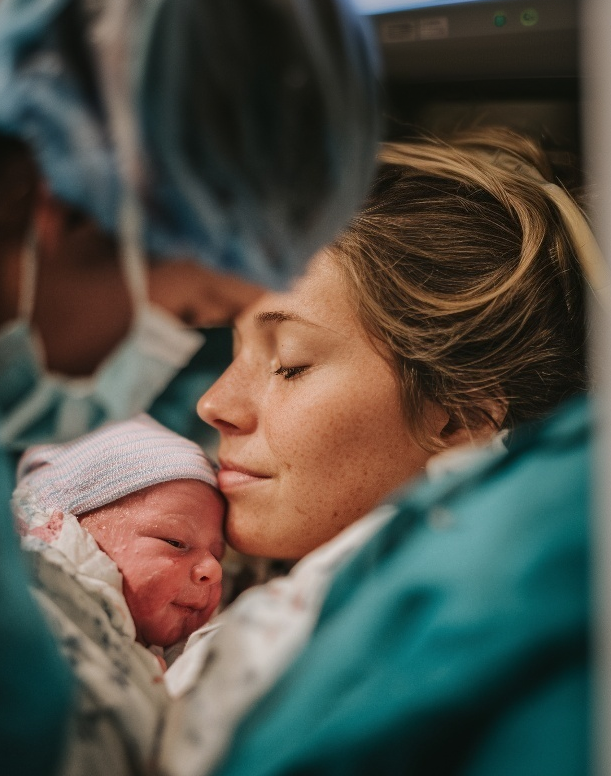85% of women giving birth
vaginally experience tears.²
Tear degrees and prevalence
While 3rd- and 4th-degree tears are the most severe and often result in long-term consequences, 2nd-degree tears — the most common type—also require interventions and significantly impact women’s short- and long-termquality of life. (1)
consequences
-
• Persistent perineal pain (up to 3 months postpartum; more severe with deeper 2° tears) (2)
• Increased analgesic use after severe 2° tears (3)
• Postpartum hemorrhage risk (4)
• Limited mobility and activity due to pain or wound healing (5)
• Disrupted breastfeeding (stress response -> reduced oxytocin/prolactin, impaired milk let-down) (6)
• Reduced early skin-to-skin contact, affecting bonding and breastfeeding initiation (7)
• Acute psychological distress (stress, anxiety, trauma symptoms) (8)
-
• Sexual health: Dyspareunia (pain during intercourse), loss of intimacy (9)
• Urinary incontinence: Increased risk after muscle-involving tears (10)
• Anal incontinence: Increased risk after 3°–4° tears (11)
• Pelvic organ prolapse: Higher likelihood after severe tears (3°–4°) (12)
• Chronic pelvic floor dysfunction: Impaired bladder, bowel, and organ support (13)
• Reduced activity: Avoidance of exercise or lifting due to leakage/heaviness (14)
• Work limitations: Reduced concentration and productivity due to pain or continence issues (15)
• Mental health: Higher risk of depression, anxiety, and post-traumatic stress symptoms (16)
• Relationship strain: Sexual dysfunction, caregiving burden, emotional stress (17)
•Weakened maternal–infant connection: Linked to trauma, recovery difficulties, and ongoing stress (18)
Developed with midwives, to fit naturally into exisiting workflows.
While childbirth forces cannot be eliminated, the ASISU device is designed to reduce the risk of tearing by distributing forces and lowering stress peaks in the tissue. Its soft, transparent design is designed to be compatible with clinical practice, minimally invasive, and unobtrusive for both midwives and mothers.
1 Macedo, M. D., Risløkken, J., Rotstein, E., Benth, J. Š., Ellström Engh, M., & Siafarikas, F. (2024). Pelvic floor symptoms according to the severity of second‐degree perineal tears within 12 months post‐partum: A longitudinal prospective cohort study. Acta Obstetricia et Gynecologica Scandinavica, 103(7), 1366-1376.
2 Risløkken, J. M., Bø, K., Macedo, M. D., Engh, M. E., & Staer-Jensen, J. (2024). The severity of second-degree perineal tears and perineal pain during three months postpartum: A prospective cohort study. Midwifery, 131, 103801.
3 Akhtamova, N. A., Shavazi, N. N., & Katkova, N. Y. (2022). Predictors of Postpartum Hemorrhage in Vaginal Deliveries: Retrospective Observational Study. International journal of health sciences, 6(S9), 3438-3444.
4 Kindberg, S. F. (2009). Perineal lacerations after childbirths; studies within midwifery practice on suturing and pain relief.
5 Fletcher, S., Nosek, M. A., & Rizk, D. E. (2014). Mobility impairments and pelvic health disorders in women: the need for innovative treatment and research. International Urogynecology Journal, 25(8), 1003-1004.
6 Kendall-Tackett, K. (2020). Breastfeeding and trauma: What lactation specialists need to know. Breastfeeding Medicine, 15(8), 495-500.
7 Ali, M; Fleming, V; Maxwell, C. (2024). Emerging trends in research on perineal trauma management: A bibliometric analysis of articles published since 1985. Midwifery, 134, 104003.
8 Opondo, C., Harrison, S., Sanders, J., Quigley, M. A., & Alderdice, F. (2023). The relationship between perineal trauma and postpartum psychological outcomes: a secondary analysis of a population-based survey. BMC Pregnancy and Childbirth, 23(1), 639.
9 Gommesen, D., Nøhr, E., Qvist, N., & Rasch, V. (2019). Obstetric perineal tears, sexual function and dyspareunia among primiparous women 12 months postpartum: a prospective cohort study. BMJ open, 9(12), e032368.
10 Gommesen, D., Hjorth, S., Nohr, E. A., Qvist, N., & Rasch, V. (2024). Obstetric Perineal Tears, Birth Characteristics and the Association with Urinary Incontinence Among PrimiparousWomen 12 Months Postpartum: A Prospective Cohort Study. International Urogynecology Journal, 35(10), 2033-2044.
11 Johannessen, H. H., Stafne, S. N., Falk, R. S., Stordahl, A., Wibe, A., & Mørkved, S. (2019). Prevalence and predictors of anal incontinence 6 years after first delivery. Neurourology and Urodynamics, 38(1), 310-319.
12 13 Huber, M., Malers, E., & Tunón, K. (2021). Pelvic floor dysfunction one year after first childbirth in relation to perineal tear severity. Scientific reports, 11(1), 12560..
14 Peinado-Molina, R. A., Martínez-Vázquez, S., Hernández-Martínez, A., & Martínez-Galiano, J. M. (2023). Impact and influence of urinary incontinence on physical activity levels. European urology open science, 55, 50-58. Dakic, J. G., Cook, J., Hay-Smith, J., Lin, K. Y., Ekegren, C., & Frawley, H. C. (2022). Pelvic floor symptoms are an overlooked barrier to exercise participation: a cross-sectional online survey of 4556 women who are symptomatic. Physical therapy, 102(3), pzab284.
15 Chang, S. R., Chen, K. H., Lee, C. N., Shyu, M. K., Lin, M. I., & Lin, W. A. (2016). Relationships between perineal pain and postpartum depressive symptoms: a prospective cohort study. International Journal of Nursing Studies, 59, 68-78.
16 Bužinskienė, D., & Vilutytė, G. (2024). Postpartum Dyspareunia. European Journal of Obstetrics and Gynecology and Reproductive Biology, 293, 116.
17 Makeen, M., Farrell, L. M., LaSorda, K. R., Deng, Y., Altamirano, V., Jarvis, O., ... & Lim, G. (2022). Associations between postpartum pain, mood, and maternal–infant attachment and parenting outcomes. Scientific reports, 12(1), 17814.
18 Ali, M; Fleming, V; Maxwell, C. (2024). Emerging trends in research on perineal trauma management: A bibliometric analysis of articles published since 1985. Midwifery, 134, 104003.



